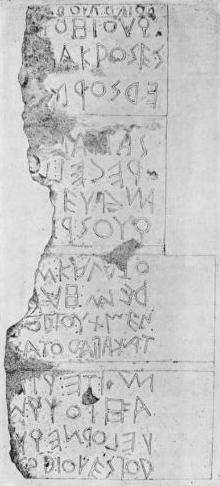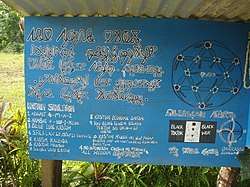Boustrophedon
Boustrophedon /ˌbuːstrəˈfiːdən/ (Ancient Greek: βουστροφηδόν, boustrophēdón "ox-turning" from βοῦς, bous, "ox", στροφή, strophē, "turn" and the adverbial suffix -δόν, "like, in the manner of"; that is, turning like oxen in ploughing)[1][2] is a type of bi-directional text, mostly seen in ancient manuscripts and other inscriptions.[3] Alternate lines of writing are flipped, or reversed, with reversed letters. Rather than going left-to-right as in modern European languages, or right-to-left as in Arabic and Hebrew, alternate lines in boustrophedon must be read in opposite directions. Also, the individual characters are reversed, or mirrored. It was a common way of writing in stone in ancient Greece.[4]

Explanation

Many ancient scripts, such as Safaitic and Sabaean, were frequently or typically written boustrophedonically, but in Greek it is found most commonly in archaic inscriptions, becoming less and less popular throughout the Hellenistic period.
By analogy, the term may be used in other areas to describe this kind of alternation of motion or writing. For example, it is occasionally used to describe the print head motion of certain dot matrix printers. In that case, while the print head moves in opposite directions on alternate lines, the printed text is usually not in boustrophedon format.[5]
The Hungarian folklorist Gyula Sebestyén (1864–1946) writes that ancient boustrophedon writing resembles how the Hungarian rovás-sticks of Old Hungarian writing were made by shepherds. The notcher holds the wooden stick in his left hand, cutting the letters with his right hand from right to left. When the first side is complete, he flips the stick over vertically and starts to notch the opposite side in the same manner. When unfolded horizontally (as in the case of the stone-cut boustrophedon inscriptions), the final result is writing which starts from right to left, and continues from left to right in the next row, with letters turned upside down. Sebestyén states that the ancient boustrophedon writings were copied from such wooden sticks with cut letters, applied for epigraphic inscriptions (not recognizing the real meaning of the original wooden type).[6]
Reverse boustrophedon


The wooden boards and other incised artefacts of Rapa Nui also bear a boustrophedonic script called Rongorongo, which remains undeciphered. In Rongorongo, the text in alternate lines was rotated 180 degrees rather than mirrored; this is termed reverse boustrophedon.[7]
The reader begins at the bottom left-hand corner of a tablet, reads a line from left to right, then rotates the tablet 180 degrees to continue on the next line from left to right again. When reading one line, the lines above and below it appear upside down. However, the writing continues onto the second side of the tablet at the point where it finishes off the first, so if the first side has an odd number of lines, the second will start at the upper left-hand corner, and the direction of writing shifts to top to bottom. Larger tablets and staves may have been read without turning, if the reader were able to read upside-down.
Example of Hieroglyphic Luwian
The Luwian language had a version, hieroglyphic Luwian, that read in boustrophedon[8] style (most of the language was written down in cuneiform).
The Hieroglyphic Luwian is read boustrophedonically, with the direction of any individual line pointing into the front of the animals or body parts constituting certain hieroglyphs. However, unlike Egyptian hieroglyphs with their numerous ideograms and logograms, which show an easy directionality, the lineal direction of the text in hieroglyphic Luwian is harder to see.
Other examples
A modern example of boustrophedonics is the numbering scheme of sections within survey townships in the United States and Canada. In both countries, survey townships are divided into a 6-by-6 grid of 36 sections. In the U.S. Public Land Survey System, Section 1 of a township is in the northeast corner, and the numbering proceeds boustrophedonically until Section 36 is reached in the southeast corner.[9] Canada's Dominion Land Survey also uses boustrophedonic numbering, but starts at the southeast corner.[10] Following a similar scheme, street numbering in the United Kingdom sometimes proceeds serially in one direction then turns back in the other (the same numbering method is used in some European cities). This is in contrast to the more common method of odd and even numbers on opposite sides of the street both increasing in the same direction.
Permanent human teeth are numbered in a boustrophedonic sequence.
In art history, it additionally means that you read from bottom left in a series of pictures; as in the stained glass windows at Sainte-Chapelle in Paris.
Another example is the boustrophedon transform, known in mathematics.[11]
Sometimes computer printers with a typewriter-like moving type head print boustrophedon text if set up incorrectly.
Additionally, the Indus script, although still undeciphered, can be written boustrophedonically.[12]

The Avoiuli script used on Pentecost Island in Vanuatu is written boustrophedonically by design.
In constructed languages
The constructed language Ithkuil uses a boustrophedon script.
The Atlantean language created by Marc Okrand for Disney's 2001 film Atlantis: The Lost Empire is written in boustrophedon to recreate the feeling of flowing water.
The code language used in The Montmaray Journals, Kernetin, is written boustrophedonically. It is a combination of Cornish and Latin and is used for secret communication.[13]
See also
- Ambigram
- Mirror writing
- Sator square is read boustrophedonically in one interpretation
- Stoichedon
References
- βοῦς, στροφή, βουστροφηδόν. Liddell, Henry George; Scott, Robert; A Greek–English Lexicon at the Perseus Project.
- Harper, Douglas. "boustrophedon". Online Etymology Dictionary.
- Sampson, Geoffrey (1985). Writing Systems: A Linguistic Introduction. Stanford University Press. p. 103. ISBN 0-8047-1756-7.
- Threatte, Leslie (1980). The Grammar of Attic Inscriptions. W. de Gruyter. pp. 54–55. ISBN 3-11-007344-7.
- "Boustrophedon". The Jargon File. Retrieved May 7, 2019.
- Sebestyén, Gyula (1915). A magyar rovásírás hiteles emlékei. Budapest. pp. 22, 137–138, 160. ISBN 9786155242106.
- "Rongorongo-Hieroglyphs written with shark teeth from Easter Island, remain indecipherable". hurriyet. 2016-09-07.
- Campbell, George Frederick (2000). Compendium of the World's Languages. Routledge. p. 78. ISBN 0-415-20296-5.
- Stilgoe, John R. (1982). Common Landscape of America, 1580 to 1845. New Haven: Yale University Press. p. 104. ISBN 9780300030464.
- Taylor, B.C.L.S., W.A. (2004) [1975]. Crown Lands: A History of Survey Systems (PDF) (5th Reprint ed.). Victoria, British Columbia: Registries and Titles Department, Ministry of Sustainable Resource Management. p. 21.
- Weisstein, Eric W. (2002). CRC Concise Encyclopedia of Mathematics (Second ed.). Chapman & Hall/CRC. p. 273. ISBN 1-58488-347-2.
- Possehl, Gregory L. (2003). "The Indus Civilization: An introduction to environment, subsistence, and cultural history". In Weber, Steven A.; Belcher, William R. (eds.). Indus ethnobiology: New perspectives from the field. Lanham MD: Lexington Books. pp. 1–20.
- Cooper, Michelle (2008). A Brief History of Montmaray. Australia: Random House Australia. ISBN 9780375858642.
External links
| Look up boustrophedon in Wiktionary, the free dictionary. |
| Wikimedia Commons has media related to Boustrophedon. |